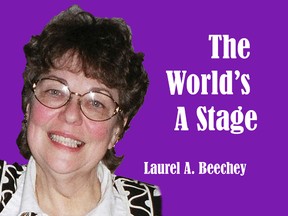It's been a tough winter on critters too

Article content
A winter that used to be, returned to a world that didn't know how to handle it. Our winters have changed so much over the last 20 years that returning
to a fairly consistently cold winter has caused problems in nature. All winter long, here in Tillsonburg, robins were sighted and geese never left.
They say the sun in winter is as warm as it is in the summer, even though surrounded by ice and snow. Is that why the roads melt at -10C and why many
of the trees have springtime buds showing?
Although we have had a mostly a very cold winter we still have had the few days where temperature climbed above freezing, before plummeting again. In that time, bats come out of hibernation… and can't go back and because there are no bugs, they die. That is why I have had so many headaches too.
This past fall, there were more baby squirrels born than in the normal springtime season. Baby squirrels last year were born (and orphaned) at the end of January not March! All the thaws confuse nature's cycle and animals think it is spring when it is not.
Babies born so early can have a litter themselves in the fall, however there is not enough food during the winter for good growth, and the babies usually are small.
This past December I had a lactating mother squirrel at my feeder. All the rehabbers I contacted were stunned. I wondered if the wee babies lived with no fur in -23C. Mom must have been exhausted trying to find enough food and keep them warm.
For the first time in the middle of winter I got a lot of calls telling me about skunks and raccoons, out in back yards in the middle of the day. These animals usually estivate, which is a mild type of hibernation, where heart rate and respirations do slow down, and the animals do sleep more.
But they are usually only inactive for a few weeks in the coldest weather and/or heaviest snows. They use the fat they store up on their bodies in the fall to cover the lean winter and into late spring, until food is available again. So why were the animals out in the middle of the winter?
I am guessing, but I would suspect that because the deep freeze came early and stayed they used too much of their fat up early. They were hungry and
out looking for food.
Having lived with skunks for years, I can tell you they don't like garbage or birdseed, so when you see raccoons, skunks and opossums eating birdseed, they are very, very hungry.
People were afraid that seeing these animals during the day meant they had rabies. No. They were hungry. We have not had rabies in SW Ontario for quite a while now. If you see an animal, like raccoons or skunks, acting unusually, staggering, with crusty, weeping eyes and nose, green eyes that seem to glow and looking sick, they most likely have distemper.
Unfortunately there is no one to help these animals. All the wildlife rehabilitators in the area, like myself, rescue, rehabilitate and release babies. There are a lot of rules and regulation from the Ministry of Natural
Resources regarding what you can do with wildlife. Right off the bat, it is illegal for you 'have' wildlife in your possession for over 24 hours, just enough time to supposedly find someone to help. But there is no help for diseased or injured adult wildlife. Several years ago, when the town was negotiating for an animal control company, I asked if they might include pickup and euthanizing of diseased or injured wildlife, as most people do not have the knowledge, caging or money to capture them and get them to a vet to be put down.
The town would not include wildlife in the duties of animal control. So if you have a distempered animal in your yard, you pretty much must leave it alone, which means it will infect other wild and domestic animals before dying a slow, painful death.
If a wild animal is threatening humans you can call the police to shoot it, however they don't like doing it and it is a terrible waste of police time and energies.
I was told several years ago at a wildlife seminar on urban wildlife by an MNR representative that the municipalities were responsible for wildlife within their limits, however that information was either wrong or has been changed. I called our MNR representative in Aylmer a few weeks ago and was informed that the property owner is responsible for the wildlife on their
property.
There are rules no one knows about, like the distance you can trap and move skunks and raccoons (one kilometre). It is against the law to use poisons or adhesives to capture animals. It also means that you are responsible for the diseased and injured adult wildlife on your property. I would then have to presume that the town is responsible for the animals when they are on municipal property. You might want to Google 'MNR Wildlife and protection of Property: What's Legal in Ontario' and learn about your responsibilities.
Whenever spring comes, remember it is the season for babies. Check the tree before cutting it down. If there is a nest of squirrels, raccoons, skunks, etc where you don't want them, use a safety light and turn their dark nest into light 24 hours a day.
Put pounding bass music on. Pour Pinesol near the entrances, they hate the smell. It may take a day or two for Mom to make a new nest and move the babies but she usually will. Everyone is safe and happy and you didn't spend hundreds of dollars having them moved!